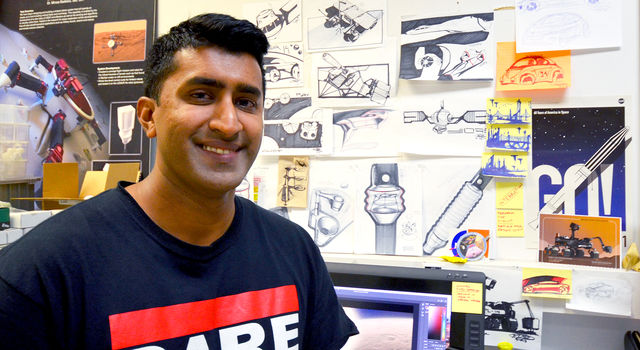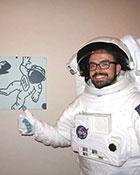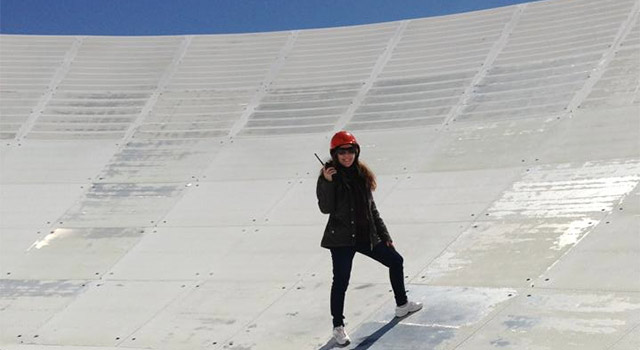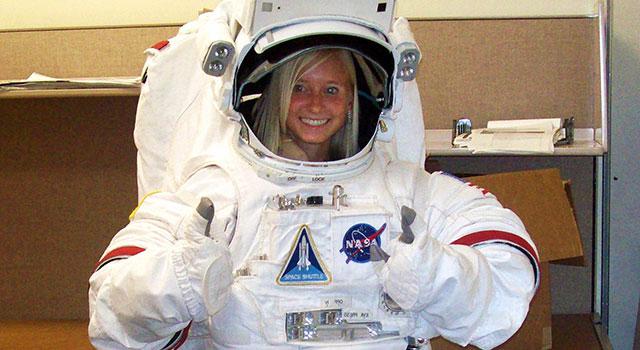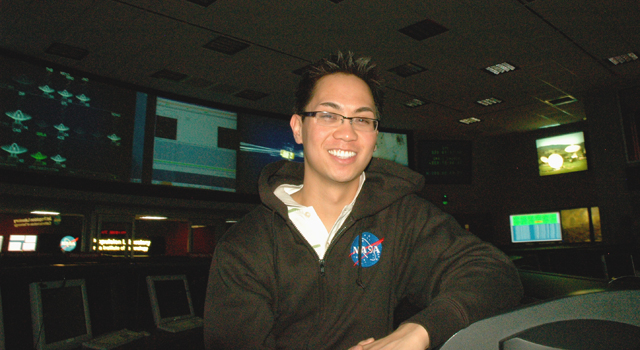Meet JPL Interns | October 15, 2018
Seeing Science: Using Visualizations to Help NASA Study Wildfires
With wildfires around the world occurring increasingly often and burning over a longer portion of the year, scientists at NASA's Jet Propulsion Laboratory are working to understand whether the blazes could have long-term impacts on global climate change. In some respects, it’s a tough question to answer – not because of an absence of data, but because of an overabundance. That’s where intern Jarod Boone, a computer engineering student at Brown University, comes in. As part of a program at JPL that brings together designers, computer programmers and scientists to answer data-heavy science questions using visualizations, Boone spent this summer helping climate researchers visualize tens of thousands of files containing wildfire data collected by instruments on NASA’s Terra satellite. Boone shared what it was like visualizing wildfire data as more than a dozen wildfires burned across California (where JPL is located) and how he never quite got used to JPLers’ tendency to speak in acronyms.
What are you working on at JPL?
I'm doing the programming for a data visualization tool to help researchers who are using the Terra satellite analyze wildfire data and how high these fires inject into the atmosphere. That's a question scientists are really concerned with because you have all these fires burning up matter, and all the matter that they burn goes into the air and just floats around for many, many days afterward. We don't really know how exactly that affects global climate change, so it's good to take a look at the data.
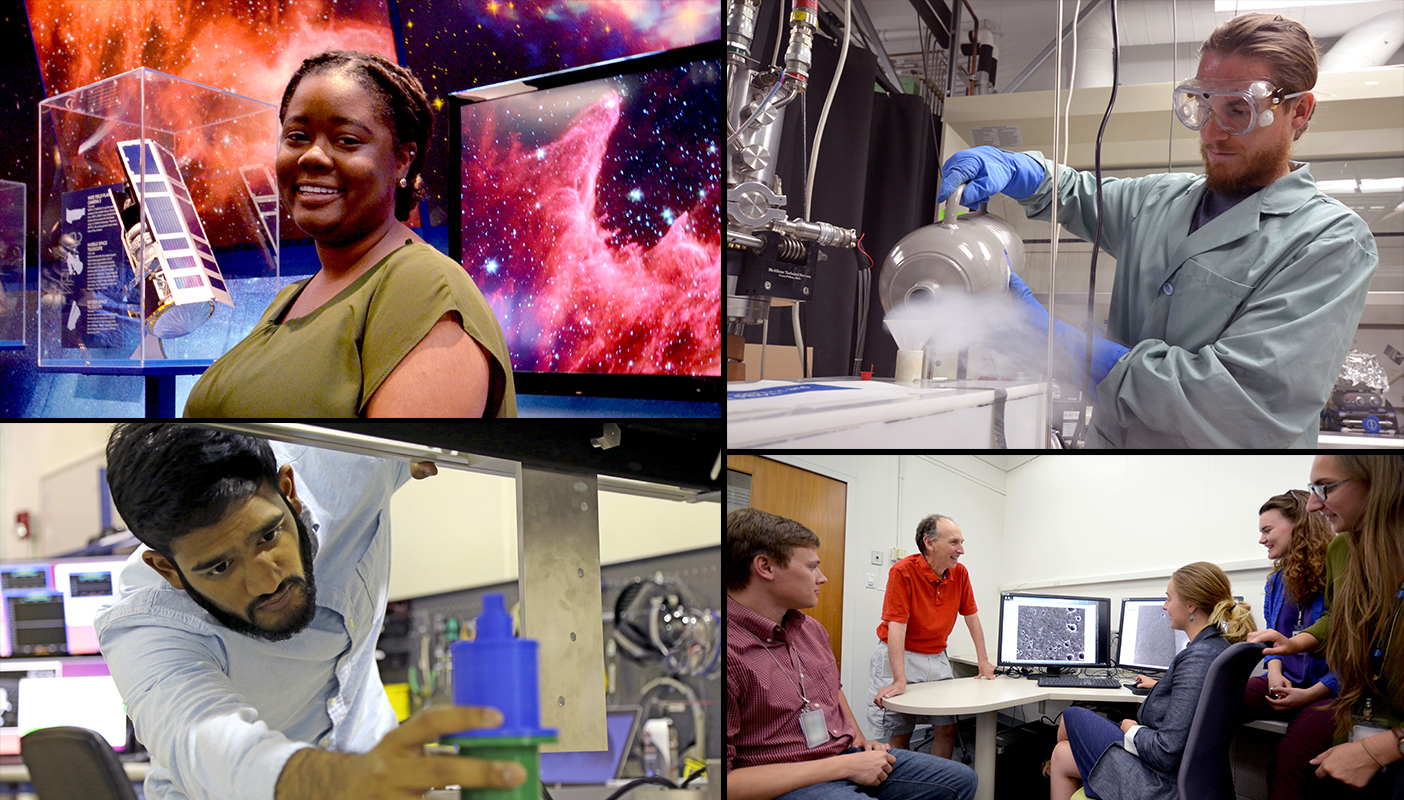
Meet JPL Interns
Read stories from interns pushing the boundaries of space exploration and science at the leading center for robotic exploration of the solar system.
Have you discovered anything so far from these visualizations?
Not quite yet. So the [Data to Discovery Visualization Program] that I’m a part of is sort of a unique program here at JPL. We have two designers and three computer science teams, and we have three projects that we work on. It's very design focused. So in the course of my projects, we have several weeks of what we call contextual inquiry, which is going in and doing interviews, creating prototypes and basically trying to get an idea of what scientists do for their workflow, because it’s kind of hard to conceive of what you would do to answer a scientific question if you don't have a scientific background. So we spend a lot of time getting to know what the scientists are trying to accomplish. We're trying to make the best interface possible for them to use this data. That's actually a huge problem in science: There's a huge barrier to entry with a lot of these data sets, so it discourages things like exploratory science.
Have you been adding all the recent wildfires in the western U.S. to your data set?
I'm mostly working with older fires because it takes a bit of time to digitize the fires that are imaged by the Terra satellite. They have to go through this process where they take a bunch of images of the fire – because you have these flat images and you're trying to get plume height and the satellite is moving – and they essentially need to stitch together the images of the fire to get an idea of how high the smoke plume is, which is quite a process. And it has to be done one by one. But there are enough older fires for us to work with.
You're from Massachusetts, a state that doesn't have a lot of wildfires. Has being in Southern California during all the wildfires this summer changed your perspective on how to go about these visualizations?
It's a little hard because the visualizations and working with all the satellite data is so detached, and they're really abstracted away from any actual fires. So it's like I'm just seeing all these data points and getting all these data products, like optical depth. I don't really know what that is, so when I see a real fire, I'm like, "Whoa, that's what that is." But there's not really a huge cognitive connection. It's definitely cool to be able to work with something that's pretty pertinent and definitely a problem in California.
What's the ultimate goal of the project both for you and for JPL?
For JPL, it is to refine our ideas of climate models and better take fires into account. The global climate models right now do a fairly poor job of taking fires into account because it's really difficult. They happen so sporadically. It's not a fluid weather system. It's these discrete fires, and they're just huge dumps of energy. How do we account for that? So that's definitely the end goal for JPL.
I am not a climate scientist. I will not be doing any updates to the climate models, but I do hope to encourage exploratory research. And I'm sort of trying to introduce principles of design and human-centered interfacing and accessibility to climate scientists. Actually, one of my mentors was very excited about what I was working on and had me submit an abstract for the [American Geophysical Union Fall Meeting]. So visualizing is important. You should be able to conceive of the data you're using.
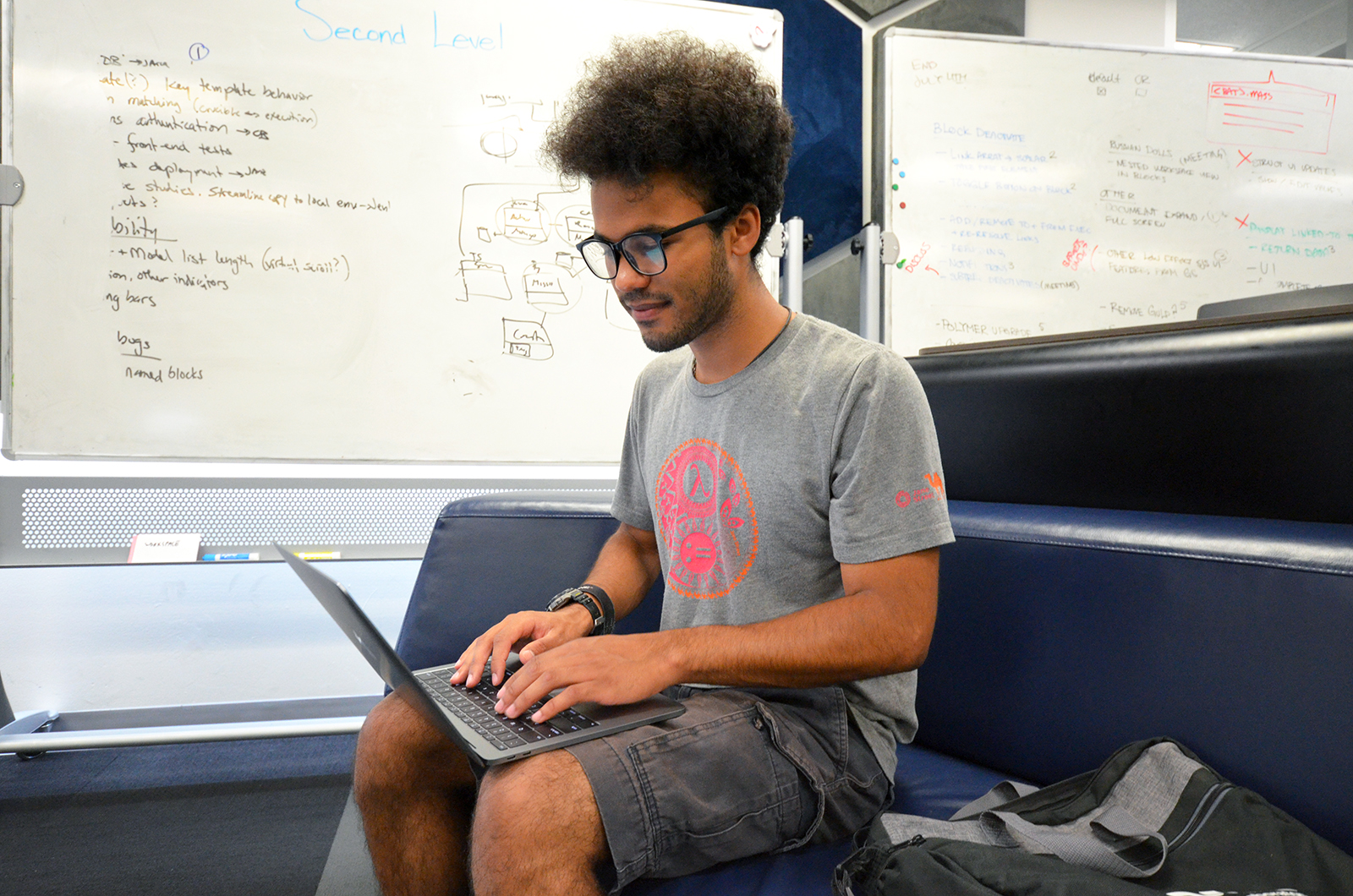
Image credit: NASA/JPL-Caltech/Kim Orr | + Expand image
How did you get involved in the program that brought you to JPL to do this work?
I had done a lot of visualization work at my school. Not on purpose, tangentially. I worked at the Brown University Center for Computation and Visualization, so we had a lot of people coming in wanting to do some kind of research visualization and they had a lot of technical problems. So I sort of got sucked into the visualization and research-aid world. One of my bosses knew Santiago Lombeyda, one of the mentors in this program from Caltech, and he said he was looking for data visualization students who were well versed in that and able to do computer science. JPL seemed pretty cool, so I decided to apply.
What are you thinking you want to do eventually?
So long, long term, I have this vision of humanizing computer systems. A lot of software developers don't know entirely how systems work. A lot of consumers are still confused by computers, and we're still using a bunch of folders spread out to represent files rather than something more intuitive or something that represents the data better. The fact that most users need to troubleshoot online to figure out how to use their computer and answer how to fix certain problems is a problem. I feel like we know enough about computers at this point and this generation is, in general, literate enough about computer science to be able to understand what's going on. We can possibly do a lot better making operating systems transparent. That's what I would like to do. I think that would be a cool project.
Is there a particular place that you'd want to do that?
In practice, I would just like to work a little bit in industry, doing systems development either in hardware or software. It's really cool to work with a data system like this, a satellite that has a lot of nuanced issues with how you get the data and what you can do with the data and how you transmit it back and forth and, at the end, what you do with that data problem.
What's an average day like for you?
So we actually split up a decent amount of our time between here and Caltech [which manages JPL for NASA]. Most days I'll have meetings with our research groups just to touch base and see what's happening. On Mondays, we'll have [critiques] all day, which is where our mentors review our projects up to that point. Then, pretty much the rest of the day I'll spend meeting with my designers and programming. Sometimes I go for walks or explore the campus a little bit. But most of the time, I'm just holed up doing the computer thing.
What's been the most JPL or NASA unique experience you've had so far?
During the second meeting that I had with my mentor, Abigail Nastan, she used like five acronyms in the same sentence. And I was just, "Can you just use words?" [Laughs.] You guys should just have an acronyms cheat-sheet for interns.
Also, going to the Mars Yard, sitting in the rocks. Every experience here is a NASA experience.
If you could travel to any place in space, where would you go and what would you do there?
In space? I mean, Earth is really cool. I guess I'd probably go to Jupiter, just because something fishy is going on there. [Laughs.] That planet is too big. Also, I just don't trust gas giants. What do you mean, you don't have a surface? I definitely would not go on Jupiter – I'd just watch it from afar.
Explore JPL’s summer and year-round internship programs and apply at: https://www.jpl.nasa.gov/edu/intern
The laboratory’s STEM internship and fellowship programs are managed by the JPL Education Office. Extending the NASA Office of Education’s reach, JPL Education seeks to create the next generation of scientists, engineers, technologists and space explorers by supporting educators and bringing the excitement of NASA missions and science to learners of all ages.
TAGS: Internships, Higher Education, Career Guidance, Computer Science, Visualizations, Data, Earth Science, Wildfires, Black History Month
Meet JPL Interns | October 1, 2018
The Art of Planning to Return the First Samples From Mars
While the world of engineering is a familiar one to Omar Rehman (his major is transportation design and he comes from a family of engineers) his internship at NASA’s Jet Propulsion Laboratory is all about bridging the gap between form and function. NASA’s next Mars rover, currently in development and planned for launch in 2020, will acquire a set of carefully selected samples of rocks and surface material and store them in sealed tubes for possible return to Earth by a future mission. Returning samples from Mars is a complicated problem. So, a team at JPL is taking an in-depth look at how it could be done. In addition to using his transportation design background to help the team come up with ideas for a vessel that could bring the samples to Earth, Rehman is using visual arts to convey why a “sample-return mission” would be such a big deal. We caught up with the Art Center College of Design student to find out how he’s using art and design to help tell the story of how we're designing missions that might bring the first samples back from Mars.
What are you working on at JPL?
I am on a study team exploring options for a pair of missions that could take key next steps to bring samples back from Mars. I work in JPL’s Mobility and Robotics Systems section. I was primarily brought on to do visuals that translate what the mission concept is designed to do in a more cinematic and visual way so people can understand it. However, since getting here, I've been wearing multiple hats: working on visuals but also picking up my engineering hat from back in the day. I’m illustrating scenes for the Mars Sample Return study and conveying my ideas for a transportation vessel that could be used for the endeavor. The bit of engineering experience I had when I was younger has helped me understand and elaborate on the functional and mechanical side of these ideas. I'm absorbing all the knowledge, learning terminology and really getting into it – living the dream as an intern!

Meet JPL Interns
Read stories from interns pushing the boundaries of space exploration and science at the leading center for robotic exploration of the solar system.
What is a typical day like for you?
What's most important for a designer or design student is to get out your ideas. You've got to keep the practice up. So I actually sketch every morning. If you look at the wall above my desk, it's all sketches: random sketches and concept satellites, maybe some entertainment ideas, some cars here and there, spaceships – who knows? – just anything to keep my juices flowing and keep my creativity going. Then, I put that creative mind to rest for a little bit and start again.
I’ve also been working on matrices to evaluate the criteria of sample-return mission concepts and the types of innovative variations that would be compatible within the whole system. My work as a designer also comes into play when I create both visual and verbal documents that will help stakeholders understand technical aspects of the designs.
When I get home, I’ll maybe have a snack or relax and unwind, then sketch a little more before I go to bed, and do it all again.
What was the ultimate goal of your project?
I really want to convey the options for Mars Sample Return in a very cinematic way so that people can remember it. And then in terms of the engineering side, before I leave, I want to conceive a concept for a system to help transport the Mars samples once they have been captured that would be innovative but also be realistic and work within the aerospace parameters.
How might your project help the average person one day?
I'm conveying the entire story, from liftoff in 2020 to getting to Mars, collecting samples, potentially getting back up off the surface and heading back to Earth. I think it'll help people remember what Mars 2020 is all about and how it fits in the larger story of future missions that may return a sample to Earth. Hopefully they'll remember those images for years, along with the whole mission's success.
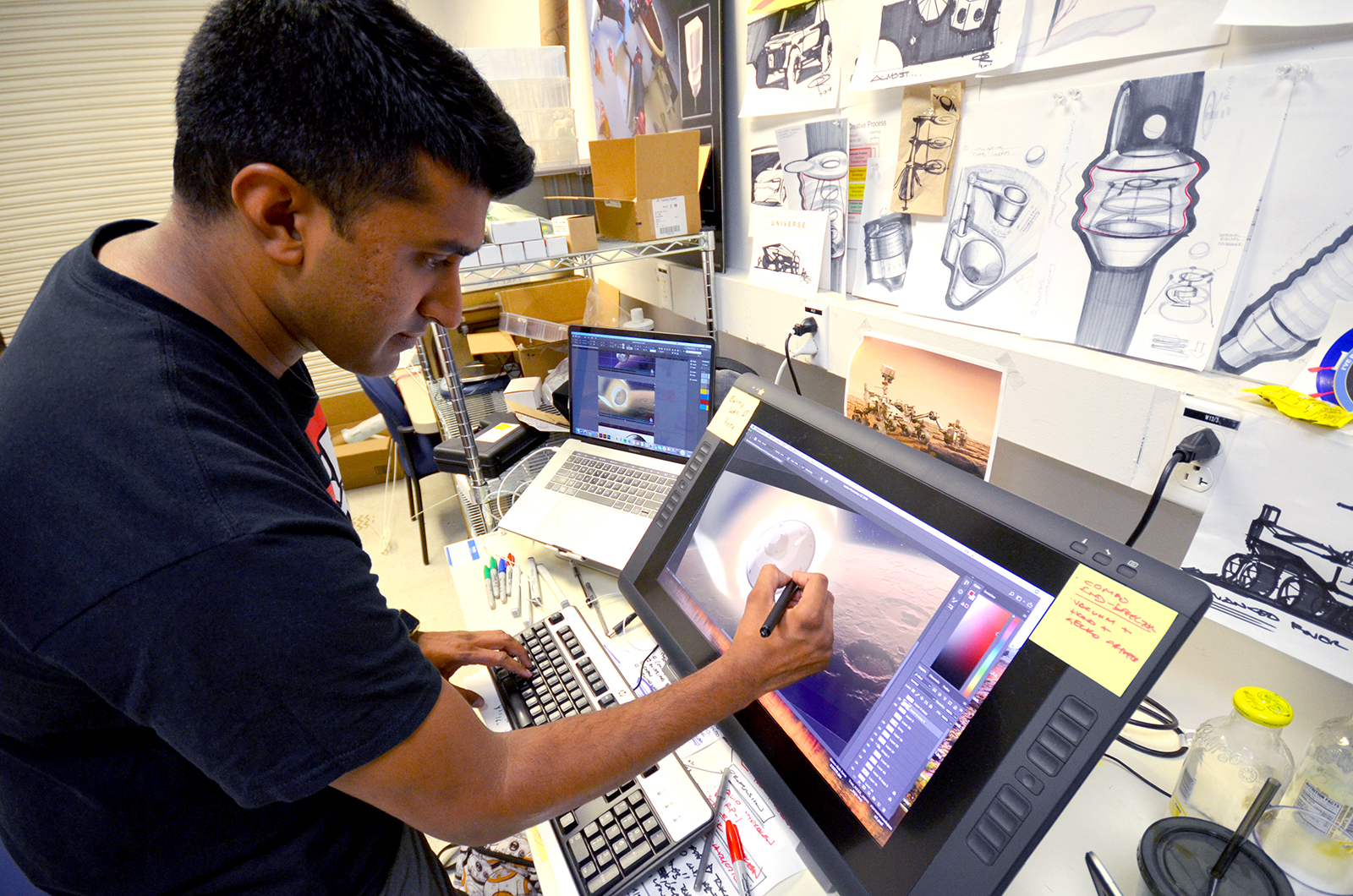
Image credit: NASA/JPL-Caltech/Lyle Tavernier | + Expand image
What is the most JPL- or NASA-unique experience you've had so far?
So many! Meeting the awesome interns. Seeing everything around JPL that's being developed and tested. That's so cool. Also, the intern before me is now interning at NASA’s Armstrong Flight Research Center in the Mojave Desert. He invited the whole team to go visit. We got to see the F-15B Eagle that is being used for NASA research. We looked at concepts they're coming up with – just crazy stuff like you'd see in movies, but it's actually being built!
How do you think you're contributing to NASA/JPL missions and science?
I think bringing the visual-designer mentality to this engineering-driven community is really good. I think that designers can contribute to these kinds of communities. We can help engineers translate ideas really fast. Maybe there are some skills that engineers lack in design and some skills that designers lack in engineering, but when they come together there's a good balance of work output and ideas, and a good combination of solid engineering and design aesthetics coming together to create a beautiful machine. There's beauty in function, but there's also beauty in function being balanced with an appropriate aesthetic.
If you could travel to any place in space, where would you go and what would you do there?
I get really sci-fi about this stuff. Imagine a theoretical scenario in which you have infinite timelines moving in parallel. Let's say it's like a guitar, and each string is you on a different timeline, moving in different places with different stories. If there is somewhere I can go that's either inside this galaxy or outside that can bring me to these different timelines and lets me come back and explore my own reality or different realities, that's where I want to go.
This Q&A is part of an ongoing series telling the story of what it takes to design, build, land, and operate a rover on Mars, told from the perspective of students interning with NASA's Perseverance Mars rover mission. › Read more from the series
The laboratory’s STEM internship and fellowship programs are managed by the JPL Education Office. Extending the NASA Office of STEM Engagement’s reach, JPL Education seeks to create the next generation of scientists, engineers, technologists and space explorers by supporting educators and bringing the excitement of NASA missions and science to learners of all ages.
Career opportunities in STEM and beyond can be found online at jpl.jobs. Learn more about careers and life at JPL on LinkedIn and by following @nasajplcareers on Instagram.
TAGS: Internships, Higher Education, Career Guidance, Mars 2020, Mars Sample Return, Mars 2020 Interns, Perseverance, Asian Pacific American Heritage Month
Internship Pathways | April 1, 2014
A Star is Born From A Deep Space Rescue
It started as a technology test mission, but NASA's Deep Space 1 had become much more. In 1999, having already made a historic up-close encounter with asteroid 9669 Braille, the "spacecraft that could" was being pushed ever further with an extended mission to encounter two comets in a single year.
But in November of that year, something went wrong. The star tracker, a device that acts as a sort of spacecraft compass, failed, rendering the craft blind in the stellar abyss with no way of relaying its valuable reserve of science data back to Earth.
For Michela Muñoz Fernández, it was a chance to do something big.
In February 2000, Muñoz Fernández, then a master's student at France's International Space University, arrived at NASA's Jet Propulsion Laboratory in Pasadena, Calif., for the start of her three-month internship. Her task was to help analyze communications between Deep Space 1 and the ground stations that make up NASA's Deep Space Network (DSN) -- a global system of powerful antennas for spacecraft communication and navigation.
As the NASA lab that had pioneered deep space communication and managed the DSN, JPL was a mecca for aspiring telecommunications engineers like Muñoz Fernández.
"My dream was always to work on telecom, doing telecom analysis for a deep space mission," said Muñoz Fernández, who before starting her master's program had worked for the company that manages the DSN complex in her native Madrid. "So for me, it was like a dream to work on Deep Space 1."
Her dream quickly evolved into a career's worth of real-world experience when, soon after starting her internship, she was thrust into a team tasked with wrenching the science data from the wayward Deep Space 1 and potentially rescuing the mission altogether.
Working with her mentor, Jim Taylor, and the flight team, Muñoz Fernández and the group quickly devised a strategy. If mission controllers could temporarily point the spacecraft close enough toward Earth, the telecom team could send commands through the spacecraft's high-gain antenna. The strategy required that Muñoz Fernández and Taylor analyze the signals coming from the spacecraft and send commands during the small window when the antenna was pointed toward Earth. If all went according to plan, a new software package would be radioed to the spacecraft instructing it to use its onboard camera as a de facto navigation tool.
"Initially, the probability of getting the high-gain antenna pointed on Earth and keeping it there for a typical communications pass was significantly below 50 percent," said Marc Rayman, who at the time was Deep Space 1's Mission Manager. "But there were two mottos I tried to get the team to adopt: 'If it isn't impossible, it isn't worth doing,' and, 'Never give up. Never surrender.' I took the second one from the movie 'Galaxy Quest.'"
The plan worked. In 2001, Deep Space 1 made a successful flyby of comet Borrelly, snapping hundreds of up-close photos of the comet. And the operation to save the mission went down as one of the most successful robotic spacecraft rescues in history.
"I got so much done in three months. It's unbelievable what we got accomplished," said Muñoz Fernández.
Having been accepted to a doctoral program at Caltech just before the start of her JPL internship, Muñoz Fernández carried the momentum from her experience into earning her doctorate in optical communications. When she came back to JPL in 2006, she was hired as a flight and project systems engineer for the Space Interferometry Mission.
These days, she divides her time between a busy schedule of research in deep space communications, techniques for model-based systems engineering for NASA missions, and task managing information architecture standards for space systems. And she says the lessons from her internship still play an essential role in her work - as does the mentoring she received from Taylor and Kar-Ming Cheung.
"I had the best mentors, that's for sure," said Muñoz Fernández. "You work with many different people, and I realize how fortunate I was that the first time I came here, I got to work with these amazing people - not just nice people, but so knowledgeable technically."
This summer Muñoz Fernández is preparing to mentor her own students, and she says she has plenty of advice from her experience to pass along to the next generation.
"It's exciting to be able to teach new generations the knowledge that you have," she said. "And it's not only that the student learns from the mentor, but the mentor can also learn from the student. They can think of something that someone who was working here for a long time didn't think about because they come with a new perspective."
 Dr. Michela Muñoz Fernández is a principal investigator at JPL. She has also worked as a systems engineer and science payload engineer on instruments and operations for the Juno mission. She currently directs research for model-based systems engineering for NASA space missions, is a task manager for information and architecture standards, conducts research on optical communications in deep space, and studies the complexity of DSN links.
Dr. Michela Muñoz Fernández is a principal investigator at JPL. She has also worked as a systems engineer and science payload engineer on instruments and operations for the Juno mission. She currently directs research for model-based systems engineering for NASA space missions, is a task manager for information and architecture standards, conducts research on optical communications in deep space, and studies the complexity of DSN links.
TAGS: Women in STEM, Deep Space Network, Deep Space 1, Internships & Fellowships, Career Guidance, Women in STEM, Hispanic Heritage Month
Internship Pathways | November 18, 2013
Lunar Lessons
When people ask me what I want to do with my life, I tell them, "Every little kid wants to be an astronaut when they grow up - but I never outgrew it." It was in eighth grade that I realized I wanted to be an astronaut and explore our solar system. The journey wasn't always easy, however. I was consistently laughed at and made fun of in high school when I would tell people that my dream was to work at NASA and one day become an astronaut. No one really expected me to stick to those dreams, let alone accomplish them.
Fast forward a few years, and I
entered college at the Florida Institute of Technology, where I
double-majored in physics and space science to learn more about stars
and comets. One moment I will never forget is orientation day for my
department. A professor asked the freshmen in the room who wanted to be
an astronaut, and every hand in the room shot up. I knew I was in the
right place.
In my sophomore year, an upperclassman sent an email around about a scholarship-internship program with NASA, called MUST (Motivating Undergraduates in Science and Technology). I figured it was a long shot, but decided to apply. To my delight, I was selected and given the opportunity to begin living out my dream by interning at Kennedy Space Center for the summer. I worked for Dr. Philip Metzger, a granular physicist who leads NASA's research into rocket blast effects for manned missions. In the Granular Mechanics and Surface Systems Laboratory, I designed and built experiments to study how the spray of lunar soil from a landing rocket will impinge upon and damage hardware at a future lunar outpost.
This NASA experience changed the course of my career, in a very good way. I suddenly realized I was far more interested in the surfaces of planets and in planetary exploration than in stars and astrophysics, and decided after that summer to pursue planetary science for my graduate studies.
I returned to KSC the next summer to work with Dr. Metzger on a new project that involved studying the compaction and magnetic properties of lunar soil using various experimental methods. We were working on developing more effective ways to store large quantities of soil for mining.
The summer before starting graduate school, I was offered an internship at JPL working on the proposed MoonRise mission, lead by my (soon-to-be) advisor, Dr. Bradley Jolliff. MoonRise would have been a robotic sample return mission to the lunar farside. I was part of a team of students who were tasked with designing an instrument to fly on the spacecraft. We designed a camera system that would have flown on the communications satellite and detected impact flashes from impacting meteorites. Unfortunately, MoonRise was not selected to fly, but the experience shaped my future career path. I realized I really enjoy the mission design and planning process and decided that summer that I wanted to both study the moon and plan for future missions.
I am now a couple years shy of having my Ph.D. in Earth and Planetary Science, and have loved the journey. My research focuses on studying the effects of rocket exhaust on lunar soil properties and volcanic complexes on the moon. Once I have finished my graduate studies, I plan to apply for a position at NASA and become involved in mission planning. I hope to work on the problems associated with rocket exhaust effects on planetary surfaces and continue to research geologically interesting locations on the moon. Ultimately, I plan to apply to become an astronaut candidate and maybe even become the first woman to walk on the moon! My NASA internships helped me realize my true passions and have paved the way for the career path I want to take. I'm incredibly happy in the field I'm in and hope that funding for both NASA and NASA education programs continues so that other students with dreams like mine have a chance to see them come true.
TAGS: Women in STEM, Planetary Science, Physics, Moon, Career Guidance, MoonRise, Women in STEM, Women at NASA
Internship Pathways | November 21, 2011
Countdown to Launch Begins for Former JPL Intern
It's five days till launch and Gregory Galgana Villar III, a mere 24 years old and a relatively new hire at NASA's Jet Propulsion Laboratory, is preparing to take part in one of the most ambitious NASA missions. In the wee morning hours of Nov. 26, Villar will step into the dark room in JPL's mission control center -- a place filled with scientists and engineers stationed at computer monitors of all kinds - to anxiously await the launch of a mission eight years in the making.
Villar is one of the youngest verification and validation engineers on NASA's Mars Science Laboratory mission team, a fact that often inspires wonder about his journey.
"I spent two years interning with three different education programs at JPL," said Villar, who participated in the Laboratory's Minority Initiatives Internship, Space Grant and Undergraduate Student Research Program as an undergrad student at Cal Poly, Pomona. "Then I started realizing I needed a job. I sent out emails to about 125 people at the lab and got a job doing cost models. After six months, opportunities with MSL came up, so I applied for a couple of positions and got one."
Tenacity has certainly worked in Villar's favor, but so has his chameleon-like ability to not only take on widely different disciplines, but also rise to success in each one. Over the years, he's gone from observing stars and planets to majoring in physics while interning at JPL with some of the most renowned scientists in the world to now working in an engineering discipline on one of NASA's flagship missions. And while his journey seems astounding to onlookers, Villar chalks it up to the basic skill of adapting.
"As with any job, it's not really your background, it's how smart you are and how well you adapt or how fast you can learn on the job," said Villar. "So long as they see that you're very motivated and smart, they'll take you on for the job."
Now part of the team that tested spacecraft operations and prepared the new Mars rover, Curiosity, for its journey to the Red Planet, Villar is making his own preparations for 7:02 a.m. PST Saturday morning when the Mars Science Laboratory launch window opens and all of the mission team's hard work pays off. It'll be just the beginning of the spacecraft's journey -- and hardly the end to Villar's. In fact, he's already set his sights on his next career move.
"I'm on the Verification and Validation team until we get to Mars," said Villar, who was also recently accepted into the astronautical engineering master's program at the University of Southern California, but is deferring until the rover has landed. "I'm working on extending my future with the mission team, but wherever JPL takes me, wherever my future takes me, is where I'll go."
TAGS: Curiosity, Launch, Internships & Fellowships, Career Guidance







